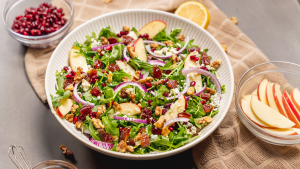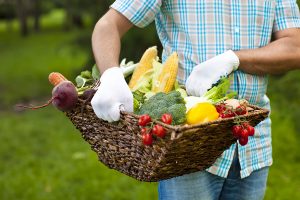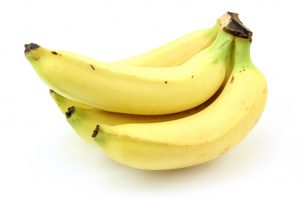By Heide Kennedy, Arizona Farm Bureau Communications Intern
One thing that I look forward to the most every fall is making cute, seasonal salads. Now you might be thinking, can’t you make cutesy salads any other time of the year? The answer is always yes, but no salads are prettier and yummier than the ones made with fall produce, at least in my opinion! So, here is a quick guide on how to make fun fall salads using seasonal produce, as well as a recipe for my favorite salad of all time!  The following guidelines are very open-ended and are meant to more so guide the process and inspire you. That way, you can make a salad with only the things you like, and none of the things you don’t like! So, grab your favorite salad bowl, and let’s get started!
The following guidelines are very open-ended and are meant to more so guide the process and inspire you. That way, you can make a salad with only the things you like, and none of the things you don’t like! So, grab your favorite salad bowl, and let’s get started!
Pick a Base:
Every good salad starts with a lush, green base. Remember, while it’s typically what is used, lettuce isn’t your only option for a good salad base! Some good options besides plain ol’ romaine lettuce include mixed greens, arugula, spinach, or kale. You can even mix a bunch of these together!
Pick a Protein:
Adding protein to your salads is a good way to not only add flavor but to make it a complete meal and help you hit your daily protein needs. Grilled and sliced chicken and steak are great, as well as turkey and salmon!
Add a Grain:
Grains in a salad take it to a whole new level. It adds flavor, and texture and makes it heartier. Some good grains to add to the top of a salad include wild rice, brown rice, barly, spelt, quinoa, or farro.
Add the Fun Stuff:
Once you get all the other items from above put together, now you can really get creative and add all the extras to make the salad just that much better. Pick out some yummy seasonal fruits and vegetables to put on top, chop some nuts, throw on some dried fruit, or sprinkle with cheese. For fall salads specifically, some seasonal ingredients that are amazing in salads include roasted sweet potatoes, roasted squash, roasted or raw brussel sprouts, pumpkin seeds, apples, and pears.
Dress it Up!
No salad is complete without a dressing. You can never go wrong with a simple olive oil and balsamic drizzle. But for something a little more flavorful that goes on almost any kind of fall salad, try making a vinaigrette! My favorite is one made with apple cider vinegar, honey, and Dijon mustard (the recipe is below). But truly, you can make a vinaigrette with all sorts of different oil, vinegar, and herb combinations.
When I make a fall salad, my absolute favorite combination of salad ingredients is:
- Kale
- Grilled chicken
- Quinoa
- Dried cranberries
- Chopped pecans or walnuts
- Chopped apples
- Roasted butternut squash
- Apple cider, honey, and Dijon vinaigrette (see below)
It’s got protein, carbohydrates, and fat, so it’s a perfect complete meal, and it has the perfect combination of salty, tangy, and sweet ingredients!
Vinaigrette Recipe:
- ¼ C. Olive oil
- ¼ C. Apple cider vinegar
- ½ Tsp. Sea salt
- 1 Garlic clove pressed
- 1 Tbs. Dijon mustard
- 1-2 Tsp. Honey
- Pepper to taste
Arizona agriculture produces lots of the seasonal ingredients needed for fall salads! Local farmer’s markets are the perfect place for finding unique and delicious fruits and vegetables to toss in your salads!
For more recipes, articles, and information about what’s in season and where to find it, check out the Fill Your Plate website!



 The following guidelines are very open-ended and are meant to more so guide the process and inspire you. That way, you can make a salad with only the things you like, and none of the things you don’t like! So, grab your favorite salad bowl, and let’s get started!
The following guidelines are very open-ended and are meant to more so guide the process and inspire you. That way, you can make a salad with only the things you like, and none of the things you don’t like! So, grab your favorite salad bowl, and let’s get started!

